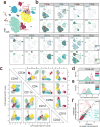Simultaneous epitope and transcriptome measurement in single cells
- PMID: 28759029
- PMCID: PMC5669064
- DOI: 10.1038/nmeth.4380
Simultaneous epitope and transcriptome measurement in single cells
Abstract
High-throughput single-cell RNA sequencing has transformed our understanding of complex cell populations, but it does not provide phenotypic information such as cell-surface protein levels. Here, we describe cellular indexing of transcriptomes and epitopes by sequencing (CITE-seq), a method in which oligonucleotide-labeled antibodies are used to integrate cellular protein and transcriptome measurements into an efficient, single-cell readout. CITE-seq is compatible with existing single-cell sequencing approaches and scales readily with throughput increases.
Figures



Comment in
-
New skin for the old RNA-Seq ceremony: the age of single-cell multi-omics.Genome Biol. 2017 Aug 24;18(1):159. doi: 10.1186/s13059-017-1300-5. Genome Biol. 2017. PMID: 28837001 Free PMC article.
References
-
- Paul F, et al. Transcriptional Heterogeneity and Lineage Commitment in Myeloid Progenitors. Cell. 2015;163:1663–1677. - PubMed
Publication types
MeSH terms
Substances
Grants and funding
LinkOut - more resources
Full Text Sources
Other Literature Sources
Molecular Biology Databases

